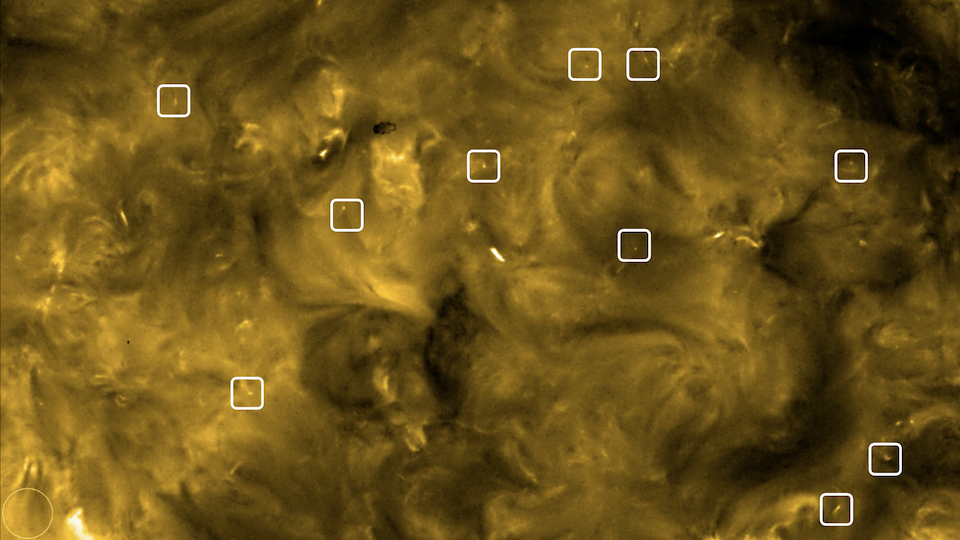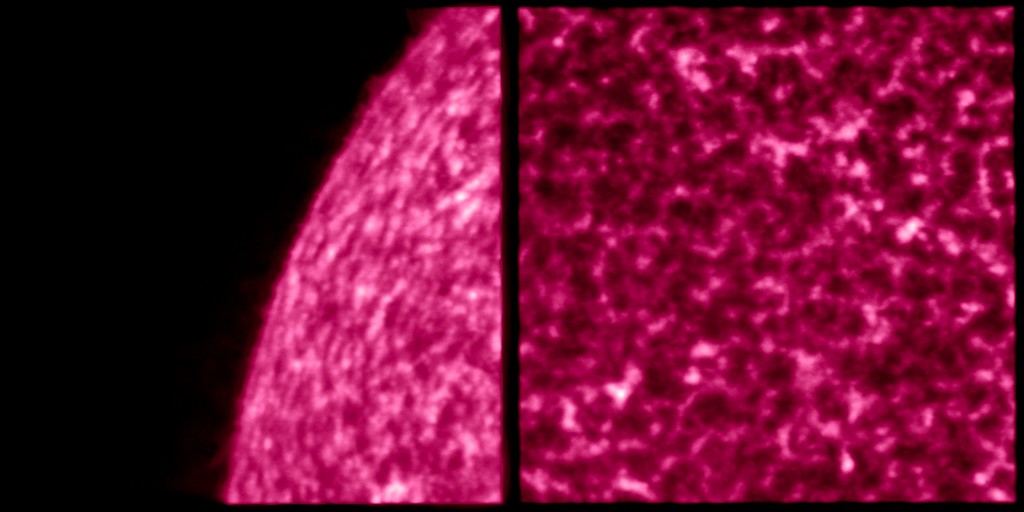First images of the telescope EUI released
The first images made by the telescope EUI onboard the space mission Solar Orbiter are released. The EUI instrument, under Belgian lead, discovered campfires on the Sun.
The high resolution images of EUI, the Extreme Ultraviolet Imager, were exactly as expected. In fact, they were too good to be true and extremely sharp. This is the very first space mission for which the testing of the spacecraft and the instruments had to be performed from home due to the COVID19 pandemic. The relief after the successful testing and ‘first light’ observations was enormous.
Solar Orbiter makes one complete orbit around the Sun in 168 days. The point of the orbit that is closest to the Sun is called ‘perihelium’. At perihelium, the speed of the spacecraft approaches the speed with which the Sun rotates around its own axis. While the spacecraft hovers closely above the solar surface, the onboard cameras are in an excellent position to photograph the solar atmosphere. The EUI cameras could make images overwhelmingly rich in small details. David Berghmans: ‘It is like zooming in on the iconic blue marble Earth and suddenly you see details which you never had expected: rivers, cows, a road with cars, smoking chimneys. This is exactly what we see here: we can see how our star works on a micro-level.’

HRIEUV – High Resolution Imager in the EUV
Full movie: https://owncloud.ias.u-psud.fr/index.php/s/87HxCK4Mef8zBk7
Campfires on the Sun – We see here a small part of the solar atmosphere. The movie shows an unexpected multitude of small loops, bright spots and dark, moving fibrils. The tiny brightening dots and loops sparked immediate excitement as they show up remarkably sharp and contrasted, ubiquitously all over the so-called “quiet Sun” where nothing seemed to happen. But now, looking at this high resolution, we see very tiny light flashes almost everywhere. These light flashes were baptized ‘campfires’ by the EUI scientists. They might contribute to the high temperatures of the solar corona and the origin of the solar wind. This is really exciting stuff. It will become even better when Solar Orbiter will go closer to the Sun.
Technical info – This high resolution movie was taken on 30 May 2020 by the “High Resolution Imager in the EUV” (HRIEUV), which is one of 3 telescopes of the EUI instrument. HRIEUV captures light with a wavelength of 17 nanometers, this is in the extreme ultraviolet. Looking at this wavelength, we see the upper part of the solar atmosphere at a temperature of around 1 million degrees! The colour on this image has been artificially added because the original wavelength detected by the instrument is invisible to the human eye. When these images were taken (May 30), Solar Orbiter was roughly halfway between Earth and the Sun, meaning that it was closer to the Sun than any other solar telescope has ever been before. This allows EUI to see features in the solar corona of only 400 km across. As the mission continues, Solar Orbiter will go even closer to the Sun. At closest approach, the instrument’s resolution will increase by a factor of two or more. The best is yet to come!
CREDIT: ESA/Solar Orbiter/EUI Team: CSL, IAS, MPS, PMOD/WRC, ROB, UCL/MSSL.
Solar Orbiter was launched on February 10, 2020, and carries 10 instruments in total. After launch, all the instrument teams prepared to test their instruments, both the hardware and the software, in the way it is usually done, however COVID19 had different ideas. The control room in Darmstadt, Germany, set-up for the commissioning, had to be closed. The ‘switch off’-buttons of all space instruments were literally pressed, a horrible moment for everyone. But after one week, it was decided to restart, with minimal staff in a fully COVID19-proof way. The rest of the work was performed from people’s homes. Teleconferences became the norm. Commands to operate EUI were given from living rooms, home offices, bedrooms … Nobody would have dared to plan it in such a way: with the team spread over several continents. The advantage was that everybody was only a mouse click away and always immediately available to search for solutions to problems that occurred during the tests. The test phase ended successfully on June 25 during an official online ‘Mission Commissioning Results Review’ meeting with more than 50 participants. The EUI team can look back on a very intense but efficient test period.
|
|
|
FSI – Full Sun Imager |
Everybody is looking forward to the new data to come. However, contrary to previous missions in which the EUI team members have participated, the distance between the Sun and the spacecraft is continuously changing. They will have to get used to the fact that the images that EUI makes are uniquely continually changing, as EUI takes pictures of the Sun from a different angle each day. At one moment, the Sun fills only part of the images, while, a few weeks later, the Sun fills the complete image. The team is excited to edit, analyse and interpret the new images. New science is on the way!

HRILYA – High Resolution Lyman alpha Imager
Magnetic footprints – The ‘network’ in the images is characteristic of a lower region of the solar atmosphere known as the chromosphere. In the chromosphere, and transition region above it, the temperature jumps from about ten-thousand to hundred-thousand degrees Kelvin. It is a region where the magnetic field of the Sun starts to play a more important role compared to the solar surface. The pattern of the network is produced by moving solar material underneath, but some bright features can correspond to the footprints of magnetic structures higher up in the corona. To be checked!
Technical info – These solar images have been produced by the “High Resolution Lyman alpha Imager” (HRILYA), which is part of the EUI instrument. The images show the solar surface in a particular ultraviolet wavelength that is produced by hydrogen, the most abundant chemical element in the universe. The wavelength is known as Lyman-alpha and has a wavelength of 121.6 nm. It can not be observed from the Earth’s surface as this wavelength is blocked by the Earth atmosphere. The raspberry colour has been artificially added to help visual identification of these images. EUI has produced these images from roughly halfway between the Earth and the Sun, closer to the Sun than any other solar telescope ever. This allows it to see small features of only a few hundred km in size.
CREDIT: ESA/Solar Orbiter/EUI Team: CSL, IAS, MPS, PMOD/WRC, ROB, UCL/MSSL.
More
EUI website: https://wwwbis.sidc.be/EUI/
Follow EUI on Twitter: https://twitter.com/EuiTelescope
Partners
The EUI project was launched in 2008 under the scientific leadership of the Royal Observatory of Belgium and the technical leadership of the Centre Spatial de Liège. EUI was developed by a European consortium with significant contributions from France (Institut d’Astrophysique Spatiale), Germany (Max-Planck-Institut für Sonnensystemforschung), the United Kingdom (UCL-Mullard Space Science Laboratory) and Switzerland (Physikalisch-Meteorologisches Observatorium Davos/World Radiation Center). The Belgian contribution was funded by BELSPO (Federal Science Policy Office) through ESA/PRODEX.
